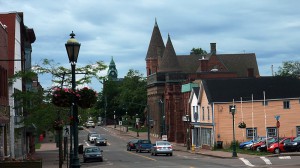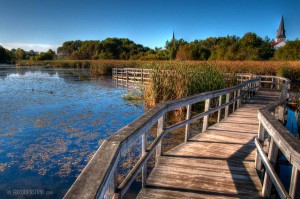
Amherst, Nova Scotia borders the Province of New Brunswick and marks the beginning of both the Glooscap and Sunrise Trails. The Town of Amherst is often remembered for its beautiful, historic streetscapes and the thousands of birds that flock annually to the nearby marshes. An interesting fact: Russian revolutionary, Leon Trotsky was incarcerated at a detention centre in Amherst after he was arrested in Halifax in 1917.
Population: 13,999
Community Links:
http://www.town.amherst.ns.ca/
http://en.wikipedia.org/wiki/Amherst,_Nova_Scotia
Fort Beauséjour
Make a stop at the provincial border to visit Fort Beauséjour, located at the head of the Bay of Fundy. Designated a National Historic Site in 1926, Fort Beauséjour reflects the time in history when the European imperial forces (France and Britain), and later Britain and the American colonies, fought for control of Eastern North America. Displays on site also tell of the area’s natural and cultural heritage.
Open 9:00am-5:00pm, June 1 – October 15. Admission charged.
Sackville Waterfowl Marsh
Visit the Sackville Waterfowl Marsh, twenty-two hectares of water, woods and meadows, just across the provincial border from Amherst. Consider taking a “Marshland Mystery Tour” – a two and a half hour walk featuring natural and human history in Tantramar. Long ago this important freshwater marsh was actually a salt marsh, flooded daily by the Fundy Tides, and a significant resource to the Mi’kmaq people who hunted the waterfowl, weaved baskets from the grasses and took nourishment from the cattail roots. When Acadians arrived in the area in the 1600s they ditched and drained the marshes to access the rich soil and use the land for farming.

Today, the wetlands are a valued water reservoir, natural filtration and purification system and an important wildlife habitat. Follow the 3km (2-mile) boardwalk to the edge of the Tantramar Marshes and appreciate the wetlands, home to ducks, songbirds, frogs, muskrats and more. Over 150 species of birds and nearly 200 species for plants have been identified in the Sackville Waterfowl Marsh. Also, on site is a Wildlife Interpretation Centre featuring panels, photos, models and exhibits that further describe the area.
Amherst Point Migratory Bird Park
A nationally protected habitat, the Amherst Point Migratory Bird Sanctuary is an incredible ecosystem and seasonal home to many species of birds. (Approximately 228 species of birds have been identified within the Amherst Point Migratory Bird Sanctuary.) One thousand hectares of marsh and forest combine to create this important sanctuary. Explore some eight kilometers of trails that wind through this diverse landscape and discover what make the Amherst Point Migratory Bird Sanctuary so special.
Tantramar Marshes
A Nova Scotia Fundy Shore Eco-Zone, the Tantramar Marshes stretch across the Isthmus of Chignecto; joining Nova Scotia to the Canadian Mainland. Combined of both salt and freshwater marshes, the salt marshes of the bay continue inland for ten kilometres and are then bordered by freshwater marshes. Named Tintamarre, meaning ‘racket’ or ‘din’, by the Acadians that first dyked the land in the 1700’s for the noise made by the local waterfowl, the Tantramar Marshes provide a rich habitat for birds and is an important feeding ground for waterfowl during migration.
Joggins Fossil Cliffs
Located at the head of the Bay of Fundy, these 75-foot high cliffs are exposed to constant tidal action and as Fundy’s 50-foot tides erode the cliffs, new fossils are revealed including a rich variety of flora, diverse amphibian fauna, important trackways and some of the world’s first reptiles.
The Joggins Fossil Cliffs became famous in 1851 with the discovery of fossilized tree trunks found in their original positions. When these trunks were closer examined, tiny bones were noticed which turned out to be one of the most important fossil discoveries in Nova Scotia. These remains were from one of the world’s first reptiles and evidence that land animals had lived during the “Coal Age”. Today the Joggins Fossil Cliffs are recognized in a world-class palaeontological site. Visit the Joggins Fossil Center to see 300-million-year-old Joggins Fossils and more.
Open June 15-September 15. Admission charged.